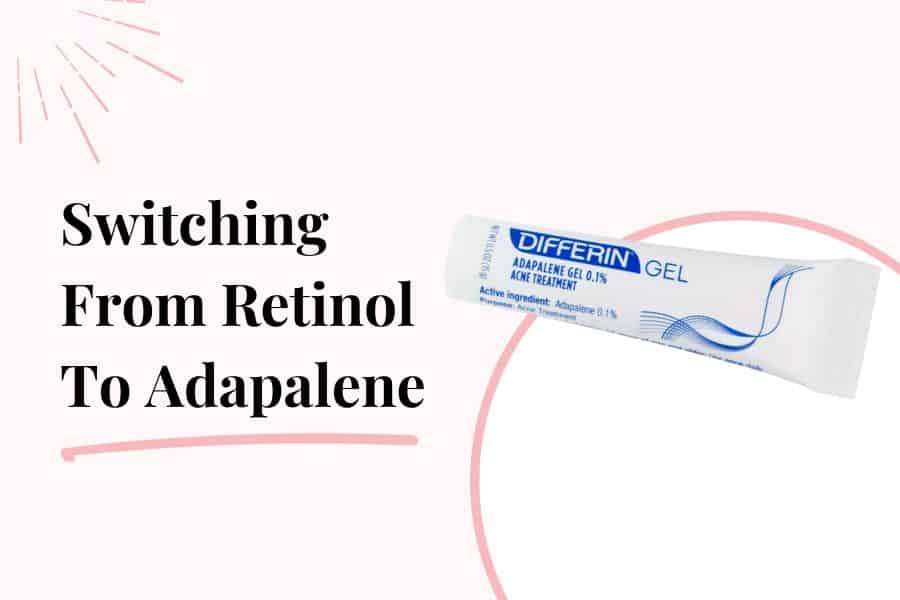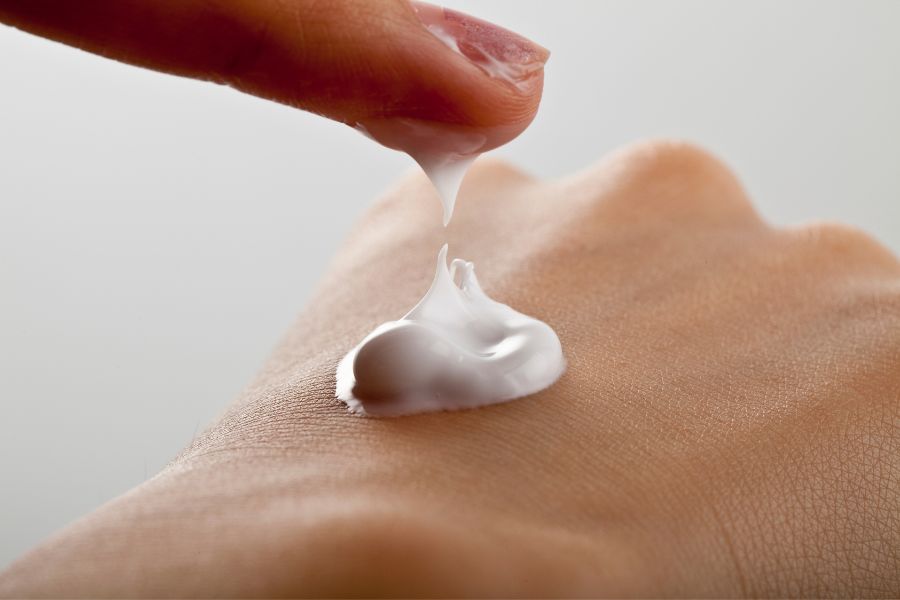Switching From Retinol To Adapalene: 6 Best Tips
This post may contain affiliate links.

If you’re thinking about switching from retinol to Differin or adapalene, there are a few things you should know. Adapalene is a stronger retinoid, so it can be more effective at treating acne and wrinkles. However, it also comes with some potential side effects, like dryness and irritation. Here’s what you need to know before making the switch from retinol to adapalene.
Retinol Vs Differin/Adapalene
Hang with me, cause this can get confusing. Both Differin and retinol belong to a group called retinoids. “Retinoids” is simply an umbrella term for Vitamin A compounds and Vitamin A derivatives.
These compounds basically shed dead skin cells and help our skin cells rejuvenate faster.
Now, there are a lot of different types of natural and synthetic retinoids. Certain retinoids are available OTC, while others are prescription-only. Now let’s dive a littler deeper into the differences between adapalene and retinol.
Retinol is a type of retinoid that’s sold OTC and helps to speed up cell turnover. Retinol can help with a variety of skin issues like acne, aging, hyperpigmentation and texture. Retinol is one of the weaker Retinoids, so it’s less irritating but also not as effective as other forms like adapalene or tretinoin.
The reason Retinol is less effective is because it has to go through two conversions for our skin to be able to use it. So when retinol is applied, it doesn’t do anything until those conversions happen. The conversion itself takes some time, which is why retinol is considered less effective than other forms like tretinoin. It also means its more gentle.
Related post: Does Retinol Actually Expire?
Differin is the brand name of the product and the generic name is adapalene. Differin is a third generation, topical retinoid. It’s a synthetic form of Vitamin A and it’s also available OTC. It was originally prescription-only, but is now available OTC.
Adapalene, or Differin, is a stronger retinoid than retinol. It’s more often used for treating acne than for anti-aging purposes. Most of the research done on adapalene is looking at its ability to treat and prevent acne. It’s also important to note that Differin is only FDA approved to treat acne and not signs of aging.
Another big difference is that adapalene has anti-inflammatory properties, which is why it’s so good for acne. It can help to reduce redness and inflammation associated with acne as well as unclogging pores and shedding dead skin cells.
Differin is more stable, which means it can be used during the daytime, whereas retinol will degrade when exposed to sunlight. Differin is also more suitable for sensitive skin, or those just starting out using retinoids. Another big difference between retinol and adapalene is that adpalene & Differin are FDA approved to treat acne and retinol is not.
So, what does this mean if you’re switching from retinol to adapalene? Well, it means that you’ll be using a stronger, more effective product. It also means that you may experience more irritation and redness as your skin adjusts to the stronger retinoid. However, with the right tips, you’ll be able to transition to using Differin without too much discomfort and side effects.
Can I Switch Between Retinol & Adapalene?

While both of them are retinoids and work very similarly, adapalene is a stronger retinoid which means if can offer better results. Many people who start using retinol eventually move on to stronger retinoids like Differin and even tretinoin. While it’s perfectly safe to switch from retinol to adapalene, keep in mind that adapalene is a stronger product so you need to gradually make the switch and make sure you’re doing it properly to avoid barrier damage and irritation.
Can I Alternate Between Retinol and Adapalene?
Since retinol and adapalene are technically different products, many people wonder if you can use them on different nights. In theory, you can alternate between retinol and adapalene without any issues. However, using both products is redundant. Both products are great for signs of aging and acne, so you can tackle these skin concerns with a single product instead of using (and paying for) two separate products.
You can alternate between Differin and retinol, but you need to always use them on alternate nights and never use them together on the same day.
Is Adapalene Gentler or Stronger Than Retinol?

Adapalene is stronger than retinol, but it’s still considered to be a gentle retinoid. Retinol has to go through two conversions before our skin can use it, which is why it’s less effective than other forms like adapalene or tretinoin. Adapalene starts working immediately on the skin, which makes it stronger and more effective. However, due to the anti-inflammatory properties of adapalene, it’s usually well tolerated with minimal side effects. Studies have shown that adapalene is the most tolerated retinoid, which makes it great for treating acne and for those with sensitive skin.
How Do I Transition From Retinol To Adapalene?
If you’re wanting to make the switch from retinol to adapalene, there are a few tips to make the adjustment period as smooth as possible.
The most important thing is to start slow and give your skin time to adjust to the stronger retinoid. Start by using adapalene or Differin just once or twice a week and gradually increase usage as tolerated.
You can also “buffer” the adapalene by applying moisturizer before applying adapalene This will help to “dilute” the adapalene so it’s not as strong and it will help your skin slowly adjust without a ton of irritation and dryness.
- Start low – Start with the lowest strength available: 0.1% is the only concentration available OTC, but a stronger 0.3% is available through prescription
- Avoid harsh products – Switch to a gentle cleanser and avoid using harsh exfoliants or physical scrubs
- Start slow – Begin using adapalene 1-2x a week and slowly work your way up to every other day or every day as tolerated by your skin
- Avoid other actives – During the adjustment phase, don’t use any other actives like vitamin c, salicylic acid, glycolic acid, etc
- Moisturize, moisturize, moisturize – Make sure to keep the skin hydrated and use a moisturizer both during the day and at night. You might even need to use a heavier moisturizer or occlusive to slug during the adjustment period
Another thing to keep in mind is that when you start to use a stronger, more effective retinoid, you are likely to experience what’s called a purge. This is when you may experience more breakouts while the retinoid works to clear out your pores. Just stick with it and remember that it’s temporary, and soon you’ll see clearer and smoother skin!
Related post: How To Switch From Tretinoin To tazarotene
When To Switch From Retinol to Adapalene

If you’re contemplating making the switch from retinol to adapalene but aren’t sure if it’s the right time, consider your skin concerns and skincare goals.
If you find that you are starting to see some signs of aging like fine lines, wrinkles and loss of firmness, making to switch to adapalene or Differin may be a good option for you as it can target those issues better than retinol.
Or if you have acne or texture issues that just aren’t improving with retinol, Differin can give you better results.
However, if you are happy with your skin, the switch may not be necessary! Retinol is a great product that can effectively treat acne and improve skin texture, so stick with it if you are happy with the results.
Related post: Can You Switch From Retinol To Tretinoin?
Switching From Retinol To Adapalene FAQ’s
Does adapalene build collagen?
Yes, adapalene can help to stimulate collagen production which helps with skin firmness, fine lines, wrinkles and other signs of aging.
Do dermatologists recommend adapalene for anti-aging?
Yes, dermatologists may recommend adapalene or Differin as a more effective alternative to retinol for anti-aging. Although it’s not as strong as tretinoin or Retin-A, it’s gentler and well-tolerated so it’s great for those that are new to retinoids or those with sensitive skin.
Does adapalene make your skin worse at first?
Yes, you may experience what’s called a purge period when you first start using adapalene. The purge can last several weeks to even several months. As the adapalene starts to work, it will unclog all of your pores, bringing the dirt, oil and bacteria to the surface which leads to breakouts. This just means the adapalene is doing what it’s supposed to.
Can I use adapalene and retinol together?
No, you should not use adapalene and retinol together as they are both retinoids and can cause too much irritation. Stick with just one product at a time. Though you can use them on alternate nights, it’s not necessary.
Switching From Retinol To Adapalene Wrap Up
Both retinol and Differin are incredible products that can target texture issues, acne and signs of aging. Although adapalene has been shown to be more effective for acne and anti-aging, retinol is still a great ingredient and is the better choice for some people depending on their skin and skin concerns. But if you’re wanting to make the switch from retinol to Differin, there are a few tips to make the adjustment period smoother. Start slow, use a low concentration and make sure to use a really good moisturizer 2x daily.





